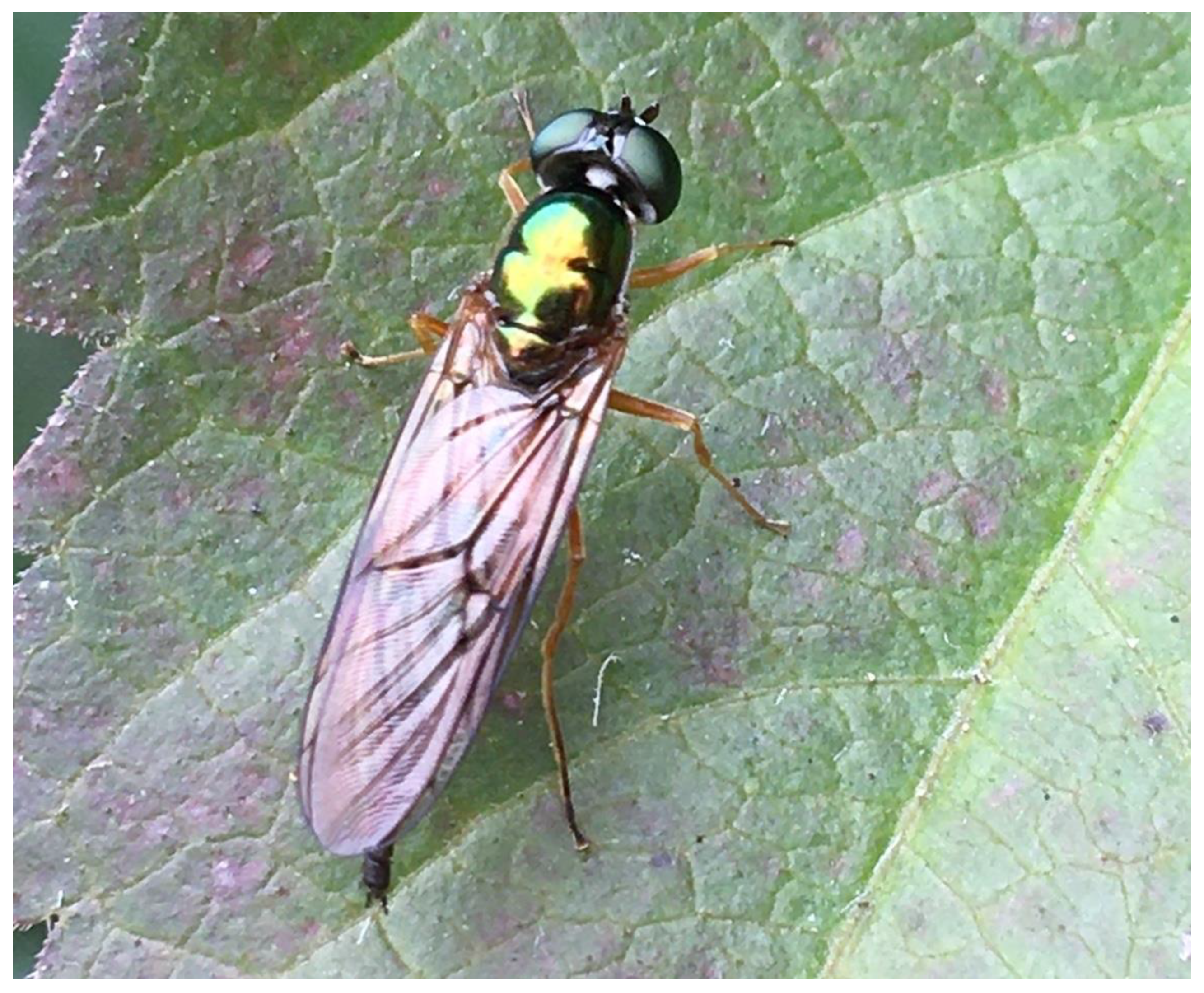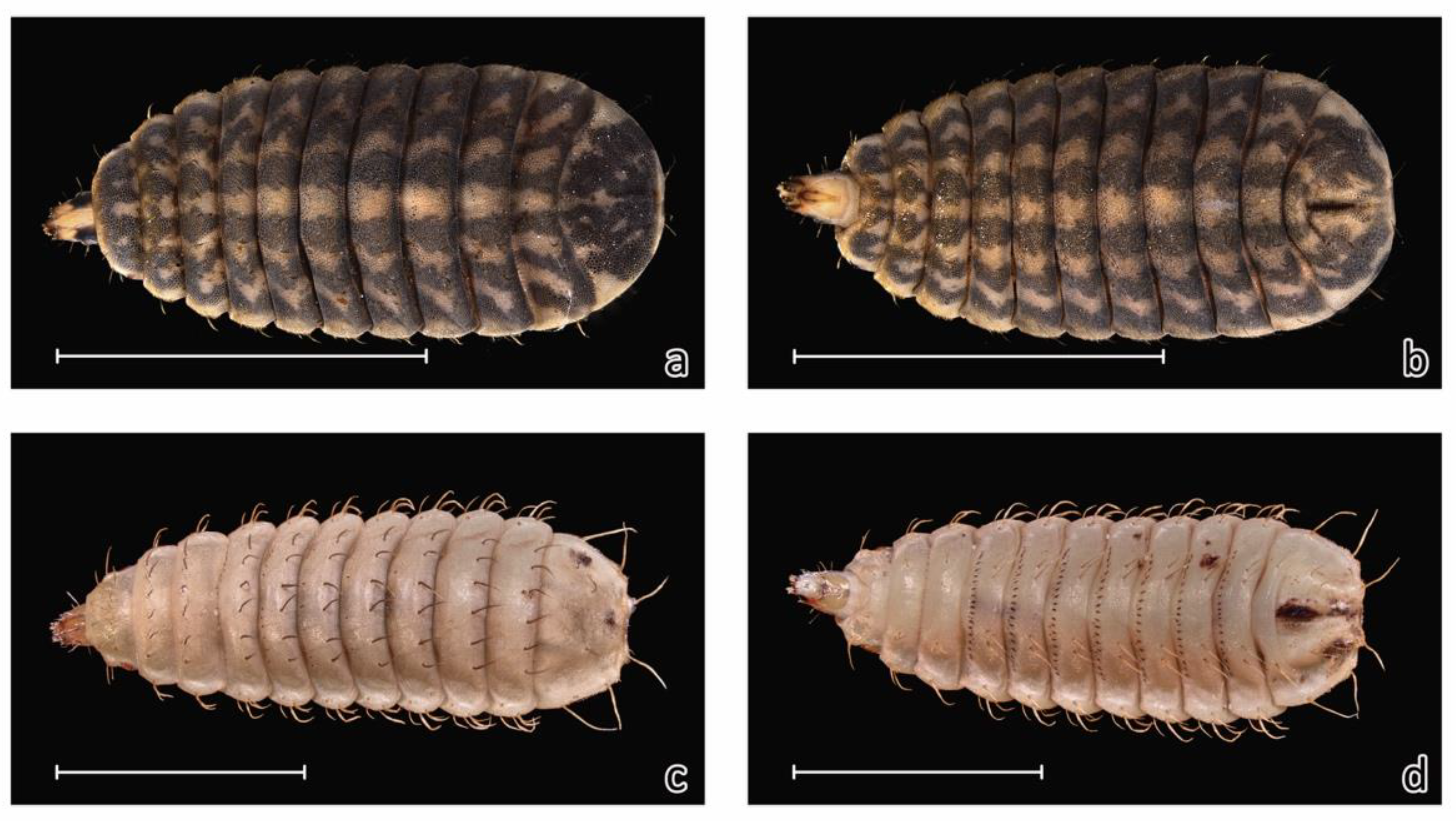New Species of Soldier Fly—Sargus bipunctatus (Scopoli, 1763) (Diptera: Stratiomyidae), Recorded from a Human Corpse in Europe—A Case Report
Abstract
:Simple Summary
Abstract
1. Introduction
2. Case Description
3. Material and Methods
4. Discussion
Author Contributions
Funding
Institutional Review Board Statement
Data Availability Statement
Conflicts of Interest
References
- Woodley, N.E. A World Catalog of the Stratiomyidae (Insecta: Diptera). Myia 2001, 11, 1–473. [Google Scholar]
- James, M.T. Stratiomyidae. Chapter 36. In Manual of Nearctic Diptera. Vol. 1. Monograph No. 27; McAlpine, J.F., Peterson, B.V., Shewell, G.E., Teskey, H.J., Vockeroth, J.R., Wood, D.M., Eds.; Research Branch, Agriculture Canada: Ottawa, Canada, 1981; pp. 497–511. [Google Scholar]
- Kovac, D.; Rozkošný, R. Insecta: Diptera, Stratiomyidae. In Freshwater Invertebrates of the Malaysian Region; Yule, C.M., Yong, H.S., Eds.; Academy of Sciences Malaysia: Kuala Lumpur, Malaysia, 2005; pp. 798–804. [Google Scholar]
- Marshall, S.A.; Woodley, N.E.; Hauser, M. The historical spread of the Black Soldier Fly, Hermetia illucens (L.) (Diptera, Stratiomyidae, Hermetiinae), and its establishment in Canada. J. Entomol. Soc. Ont. 2015, 146, 51–54. [Google Scholar]
- Roháček, J.; Hora, M.A. Northernmost European Record of the Alien Black Soldier Fly Hermetia illucens (Linnaeus, 1758) (Diptera: Stratiomyidae). Acta Musei Sil. Sci. Nat. 2013, 62, 101–106. [Google Scholar] [CrossRef]
- Caruso, D.; Devic, E.; Subamia, I.; Talamond, P.; Baras, E. Technical Handbook of Domestication and Production of Diptera Black Soldier Fly (BSF) Hermetia Illucens, Stratiomyidae; Kampus IPB Taman Kencana; PT Penerbit IPB Press: Bogor, Indonesia, 2013; pp. 1–141. [Google Scholar]
- Dunn, L.H. Hermetia illucens breeding in a human cadaver. Entomol. News 1916, 27, 59–61. [Google Scholar]
- Tomberlin, J.K.; Adler, P.H.; Myers, H.M. Development of the Black Soldier Fly (Diptera: Stratiomyidae) in Relation to Temperature. Environ. Entomol. 2009, 38, 930–934. [Google Scholar] [CrossRef]
- Lord, W.D.; Goff, M.L.; Adkins, T.R.; Haskell, N.H. The Black Soldier Fly Hermetia illucens (Diptera: Stratiomyidae) As a Potential Measure of Human Postmortem Interval: Observations and Case Histories. J. Forensic Sci. 1994, 39, 215–222. [Google Scholar] [CrossRef]
- Chick, A.I.R. Sargus bipunctatus (Scopoli) (Diptera, Stratiomyidae) on Carrion in Nottinghamshire, and Some Considerations for Forensic Entomology. Dipter. Dig. Second Ser. 2012, 19, 162. [Google Scholar]
- McFadden, M.W. Soldier Fly Larvae in America North of Mexico. Proc. U. S. Natl. Mus. 1967, 121, 1–72. [Google Scholar] [CrossRef] [Green Version]
- Rozkošný, R. A Biosystematic study of the European Stratiomyidae (Diptera). Vol. 1; W. Junk: Hague, The Netherlands; Boston, MA, USA; London, UK, 1982; 401p. [Google Scholar]
- Folmer, O.; Black, M.; Hoeh, W.; Lutz, R.; Vrijenhoek, R. DNA primers for amplification of mitochondrial cytochrome c oxidase subunit I from diverse metazoan invertebrates. Mol. Mar. Biol. Biotechnol. 1994, 3, 294–299. [Google Scholar]
- Kearse, M.; Moir, R.; Wilson, A.; Stones-Havas, S.; Cheung, M.; Sturrock, S.; Buxton, S.; Cooper, A.; Markowitz, S.; Duran, C.; et al. Geneious Basic: An integrated and extendable desktop software platform for the organization and analysis of sequence data. Bioinformatics 2012, 28, 1647–1649. [Google Scholar] [CrossRef]
- Ratnasingham, S.; Hebert, P.D.N. BOLD: The Barcode of Life Data System. Mol. Ecol. Notes 2007, 7, 355–364. [Google Scholar] [CrossRef] [Green Version]
- Clark, K.; Karsch-Mizrachi, I.; Lipman, D.J.; Ostell, J.; Sayers, E.W. GenBank. Nucleic Acids Res. 2016, 41, D67–D72. [Google Scholar] [CrossRef] [Green Version]
- de Jong, Y.; Verbeek, M.; Michelsen, V.; Bjørn, P.; Los, W.; Steeman, F.; Bailly, N.; Basire, C.; Chylarecki, P.; Stloukal, E.; et al. Fauna Europaea – all European animal species on the web. Biodivers. Data J. 2014, 2, e4034. [Google Scholar] [CrossRef] [PubMed] [Green Version]
- Demirözer, O.; Üstüner, T.; Hayat, R.; Uzun, A. Contribution to the Knowledge of the Stratiomyidae (Diptera) Fauna of Turkey. Entomol. News 2017, 126, 252–273. [Google Scholar] [CrossRef]
- Yimlahi, D.; Üstüner, T.; Zinebi, S.; Belqat, B. New records of the soldier flies of Morocco with a bibliographical inventory of the North African fauna (Diptera, Stratiomyidae). ZooKeys 2017, 709, 87–125. [Google Scholar] [CrossRef] [PubMed] [Green Version]
- Kazerani, F.; Farashiani, M.E.; Karimidoost, A.; Maghsudloo, M.K. New Data on the Subfamily Sarginae (Diptera: Stratiomyidae) from Iran. Biharean Biol. 2019, 13, 1–3. [Google Scholar]
- Nartshuk, E.P. The Character of Soldier Fly Distribution (Diptera, Stratiomyidae) in Eastern Europe. Entomol. Rev. 2009, 89, 46–55. [Google Scholar] [CrossRef]
- Roberts, M.J. Structure of the Mouthparts of the Larvae of the Flies Rhagio and Sargus in Relation to Feeding Habits. J. Zool. 1969, 159, 381–398. [Google Scholar] [CrossRef]
- McFadden, M.W. The soldier flies of Canada and Alaska (Diptera: Stratiomyidae). Can. Entomol. 1972, 104, 531–562. [Google Scholar] [CrossRef]
- Barendregt, A. Het Voorkomen van Sargus bipunctatus (Scopoli, 1763) (Diptera, Stratiomyidae) in Nederland. Entomol. Ber. 1980, 40, 33–37. [Google Scholar]
- Dušek, J.; Rozkošny, R. Revision Mitteleuropäischer Arten Der Familie Stratiomyidae (Diptera) Mit Besonderer Berücksichtigung Der Fauna ČSSR II. Časopis Ceskoslov. Společnosti Entomol. 1964, 61, 360–373. [Google Scholar]
- Oldroyd, H. Handbooks for the Identification of British Insects. Diptera Brachycera Section (a) Tabanoidea and Asiloidea IX. (4); Pemberley Natural History Books: Iver, UK, 1969; pp. 1–132. [Google Scholar]
- Sukontason, K.; Narongchai, P.; Kanchai, C.; Vichairat, K.; Sribanditmongkol, P.; Bhoopat, T.; Kurahashi, H.; Chockjamsai, M.; Piangjai, S.; Bunchu, N.; et al. Forensic Entomology Cases in Thailand: A Review of Cases from 2000 to 2006. Parasitol. Res. 2007, 101, 1417–1423. [Google Scholar] [CrossRef]
- GBIF.org. GBIF Occurrence Download. Available online: https://doi.org/10.15468/dl.jed6qb (accessed on 15 March 2021).
- GBIF.org. GBIF Occurrence Download. Available online: https://doi.org/10.15468/dl.xqkvdb (accessed on 15 March 2021).
- iNaturalist. Available online: https://www.inaturalist.org (accessed on 15 March 2021).
- Grassberger, M.; Frank, C. Initial study of arthropod succession on pig carrion in a central european urban habitat. J. Med Entomol. 2004, 41, 511–523. [Google Scholar] [CrossRef] [PubMed]
- Anton, E.; Niederegger, S.; Beutel, R.G. Beetles and flies collected on pig carrion in an experimental setting in Thuringia and their forensic implications. Med Vet. Entomol. 2011, 25, 353–364. [Google Scholar] [CrossRef] [PubMed]
- Matuszewski, S.; Bajerlein, D.; Konwerski, S.; Szpila, K. Insect succession and carrion decomposition in selected forests of Central Europe. Part 3: Succession of carrion fauna. Forensic Sci. Int. 2011, 207, 150–163. [Google Scholar] [CrossRef]
- Matuszewski, S.; Frątczak, K.; Konwerski, S.; Bajerlein, D.; Szpila, K.; Jarmusz, M.; Szafałowicz, M.; Grzywacz, A.; Mądra, A. Effect of body mass and clothing on carrion entomofauna. Int. J. Leg. Med. 2016, 130, 221–232. [Google Scholar] [CrossRef] [PubMed] [Green Version]
- Mądra, A.; Frątczak, K.; Grzywacz, A.; Matuszewski, S. Long-term study of pig carrion entomofauna. Forensic Sci. Int. 2015, 252, 1–10. [Google Scholar] [CrossRef]
- Jarmusz, M.; Grzywacz, A.; Bajerlein, D. A comparative study of the entomofauna (Coleoptera, Diptera) associated with hanging and ground pig carcasses in a forest habitat of Poland. Forensic Sci. Int. 2020, 309, 110212. [Google Scholar] [CrossRef] [PubMed]
- Amendt, J.; Richards, C.S.; Campobasso, C.P.; Zehner, R.; Hall, M.J.R. Forensic entomology: Applications and limitations. Forensic Sci. Med. Pathol. 2011, 7, 379–392. [Google Scholar] [CrossRef]
- Głowaciński, Z. (Ed.) Red List of Threatened Animals in Poland; Institute of Nature Conservation PAS: Kraków, Poland; 155p.
- Esser, J. Rote Liste und Gesamtartenliste der Kurzflügelkäferartigen und Stutzkäfer (Coleoptera: Staphylinoidea und Histeridae) von Berlin. In Rote Listen der gefährdeten Pflanzen, Pilze und Tiere von Berlin; Der Landesbeauftragte für Naturschutz und Landschaftspflege/Senatsverwaltung für Umwelt, Verkehr und Klimaschutz: Berlin, Germany, 2017; 57p. [Google Scholar] [CrossRef]
- Charabidze, D.; Vincent, B.; Pasquerault, T. The biology and ecology of Necrodes littoralis, a species of forensic interest in Europe. Int. J. Leg. Med. 2016, 130, 273–280. [Google Scholar] [CrossRef]
- Matuszewski, S. Estimating the pre-appearance interval from temperature in Necrodes littoralis L. (Coleoptera: Silphidae). Forensic Sci. Int. 2011, 212, 180–188. [Google Scholar] [CrossRef] [PubMed]
- Gruszka, J.; Matuszewski, S. Estimation of physiological age at emergence based on traits of the forensically useful adult carrion beetle Necrodes littoralis L. (Silphidae). Forensic Sci. Int. 2020, 314, 110407. [Google Scholar] [CrossRef] [PubMed]
- Bajerlein, D.; Taberski, D.; Matuszewski, S. Estimation of postmortem interval (PMI) based on empty puparia of Phormia regina (Meigen) (Diptera: Calliphoridae) and third larval stage of Necrodes littoralis (L.) (Coleoptera: Silphidae) – Advantages of using different PMI indicators. J. Forensic Leg. Med. 2018, 55, 95–98. [Google Scholar] [CrossRef] [PubMed]
- Matuszewski, S.; Mądra-Bielewicz, A. Post-mortem interval estimation based on insect evidence in a quasi-indoor habitat. Sci. Justice 2019, 59, 109–115. [Google Scholar] [CrossRef] [PubMed]




Publisher’s Note: MDPI stays neutral with regard to jurisdictional claims in published maps and institutional affiliations. |
© 2021 by the authors. Licensee MDPI, Basel, Switzerland. This article is an open access article distributed under the terms and conditions of the Creative Commons Attribution (CC BY) license (http://creativecommons.org/licenses/by/4.0/).
Share and Cite
Michalski, M.; Gadawski, P.; Klemm, J.; Szpila, K. New Species of Soldier Fly—Sargus bipunctatus (Scopoli, 1763) (Diptera: Stratiomyidae), Recorded from a Human Corpse in Europe—A Case Report. Insects 2021, 12, 302. https://doi.org/10.3390/insects12040302
Michalski M, Gadawski P, Klemm J, Szpila K. New Species of Soldier Fly—Sargus bipunctatus (Scopoli, 1763) (Diptera: Stratiomyidae), Recorded from a Human Corpse in Europe—A Case Report. Insects. 2021; 12(4):302. https://doi.org/10.3390/insects12040302
Chicago/Turabian StyleMichalski, Marek, Piotr Gadawski, Joanna Klemm, and Krzysztof Szpila. 2021. "New Species of Soldier Fly—Sargus bipunctatus (Scopoli, 1763) (Diptera: Stratiomyidae), Recorded from a Human Corpse in Europe—A Case Report" Insects 12, no. 4: 302. https://doi.org/10.3390/insects12040302





